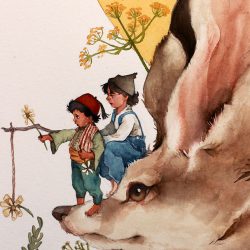Sheikha Al Habshi (b. 1999) is an artist, illustrator and designer based in Kuwait. Sheikha’s art is mainly centred around identity and self care as a form of coping in a highly technological age. Being torn between tradition and the constant change of the online arena, her art focuses on women and other marginalized figures seen in Kuwait and the Middle East, and how these figures evolve in digital spaces as well as in more conservative settings. Sheikha uses her art as her own way of taking up space, raising questions of gender roles and sexuality in a culture where tradition and privacy play an important role. She usually works in multiple mediums at once, such as painting and ink work alongside more tangible practices such as weaving and fabric.
During the visit to the UK, one of Sheikha’s most eye opening experiences was hearing about the ways in which the artists they met shared stories and created narratives through their work. Sharing stories through art can offer a sense of freedom, particularly for women, whose daily realities are often concealed in a society where privacy is the social norm. Inspired by this, Sheikha wanted to showcase some of the stories that the women of Kuwait have to offer. She did so by creating 3 large scale paintings in acrylic and one hand made weave. Each piece is meant to represent a story that she had the privledge of hearing from the people around her. The structural form of each piece is very abstract as it is meant to reflect the complicated and complex ties and weaves that make up her society and environment. The colours she uses juxtaposes the heaviness and struggle that can sometimes come with existing as an Arab women or marginalized figure.
The Making Marks project has aided Sheikha’s ability to explore different ways of communicating and conveying the stories that are hidden in plain sight. Kuwait has a long history of storytelling, as well as art forms such as textile use and weaving. Combining these two practices, she chose to weave the stories of these different figures in society that are often kept in the dark. By shedding light on issues of marriage, religious upbringings, nationality and gender she aims to display a narrative that is forgotten a lot of the times in the Kuwaiti society.
Related Projects
- الدروع (الحواجز)
- كون موازي
- ألخلل











